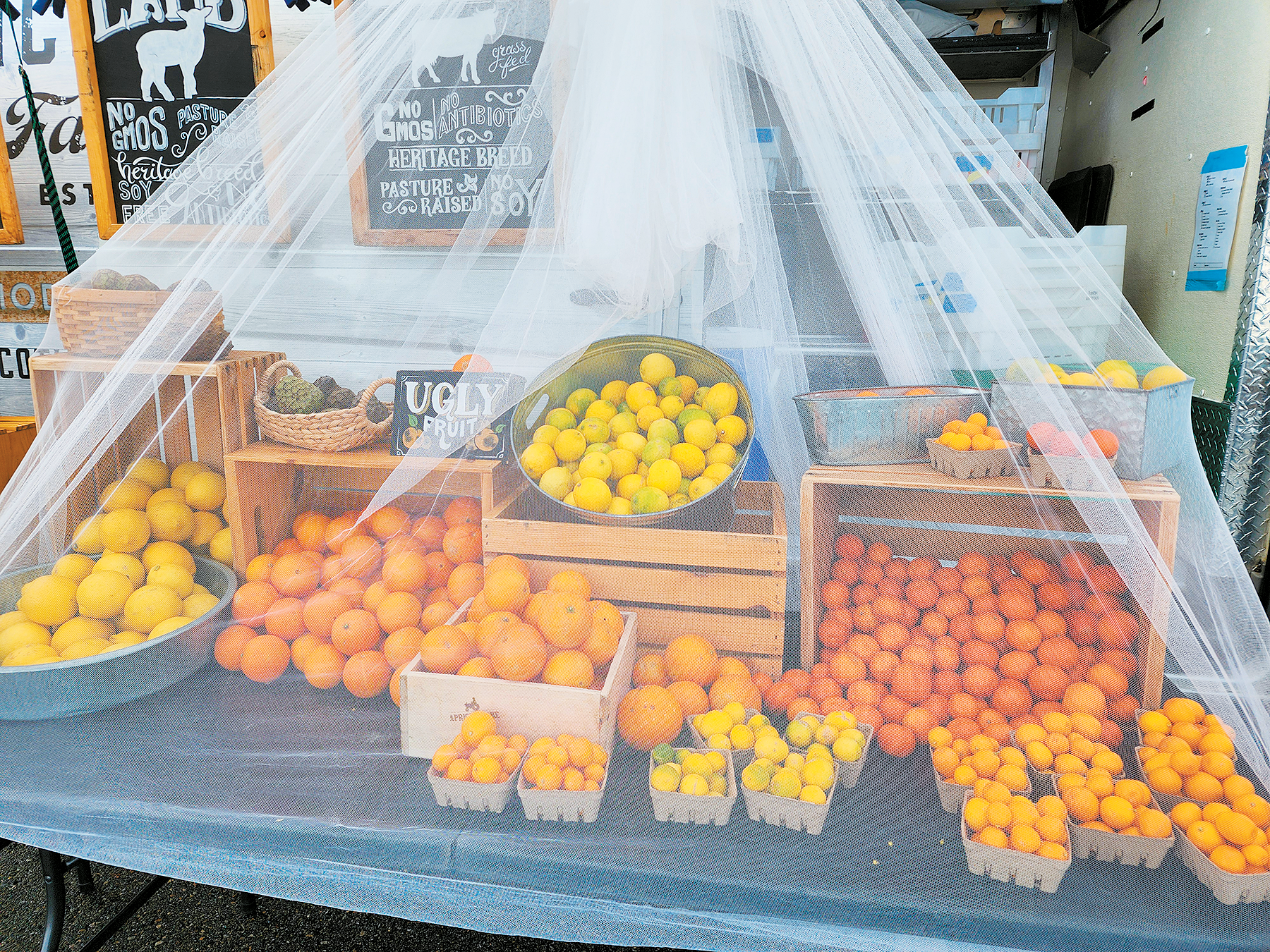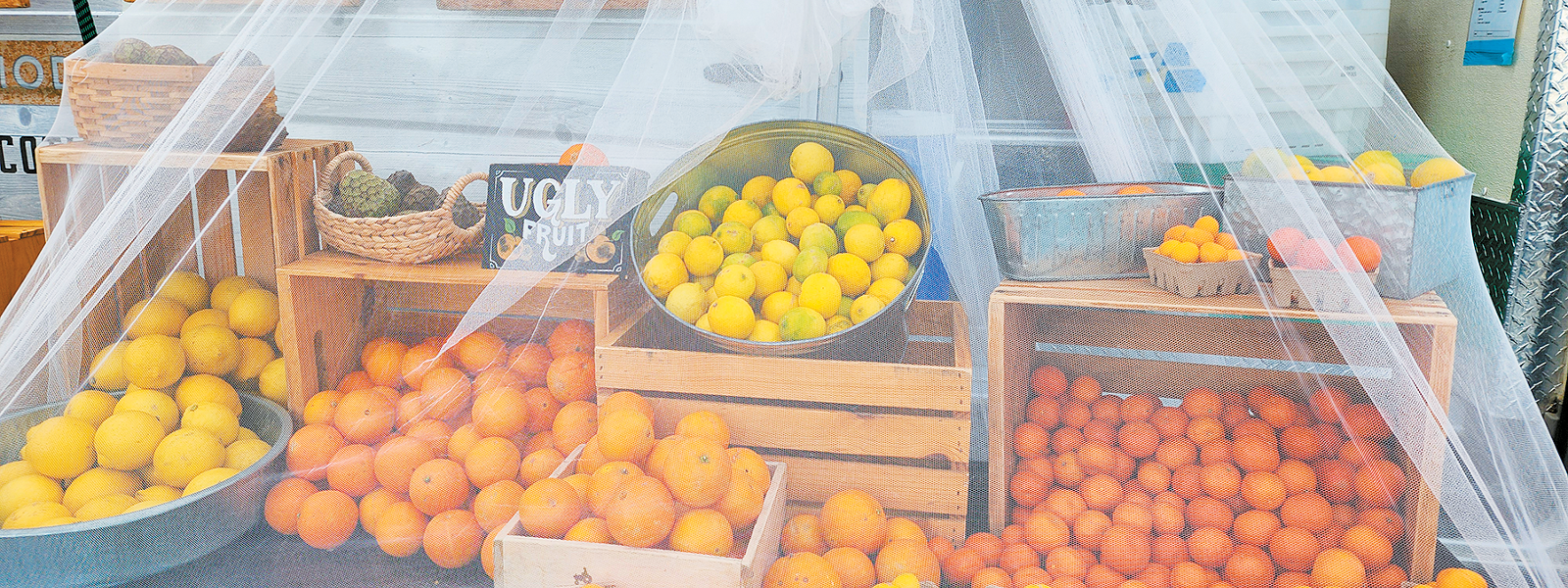Fruit fly findings, quarantines deal blow to farmers

At a farmers market in Thousand Oaks, which is at the center of a quarantine for the Queensland fruit fly, produce that can host the invasive pest must be covered with netting to prevent potential spread.
Photo/Karen Wetzel Schott

By Ching Lee
Seven counties in Northern and Southern California remain under ongoing quarantines in a battle to eradicate and stop the spread of four different species of invasive fruit flies that agricultural officials say could wreak havoc on California farms and hundreds of crops.
The Oriental fruit fly triggered quarantines in parts of Santa Clara, Contra Costa, Sacramento, Riverside and San Bernardino counties. Portions of Los Angeles County have been under quarantines prompted by findings of the Mediterranean, Tau and Queensland fruit flies. The Queensland quarantine largely affects areas of Ventura County centered around Thousand Oaks.
While two or three quarantines pop up in the state during any given year, the current ones are unprecedented because of the sheer number of flies found, said Ivan Godwyn, deputy agricultural commissioner in Contra Costa County. In an average year, the state typically detects around 75 fruit flies. In 2023, findings topped 800.
“I think those statistics tell the story,” Godwyn said.
All the quarantines started in 2023. The one involving the Tau fruit fly came in July, followed by the Oriental fruit fly in September, and the Mediterranean and Queensland fruit flies in October. Altogether, the quarantines encompass 1,248 square miles.
It’s unclear why California has seen increased detections of fruit flies, though agricultural officials agree the smuggling of contraband fruit harboring fruit flies remains a main culprit.
Godwyn noted that when travel was vastly restricted during the pandemic in 2020, the number of pests and interceptions at ports of entry went way down. This strengthens the theory that invasive pest finds are related to international travel and people illegally bringing in prohibited items.
“It’s shocking the amount of fruits and vegetables and meats taken away from passengers going through customs,” said Michelle Thom, deputy agricultural commissioner in Santa Clara County. “I’ve been there for just one day, and they had a mountain of fruit—and that’s just the stuff that they caught and took away.”
With the recent spike in pest detections, Thom said she thinks there may be other factors such as shipments coming through the mail that are purposely misidentified to evade inspection. Last year, two women from San Jose were charged with illegally importing the tropical fruit langsat that was heavily infested with fruit flies.
Historically, California pest quarantines have tended to occur more frequently in residential areas, and the current ones are no different. But the location and scope of the quarantine, type of pest, number of detections and time of year could impact farms and crops differently.
In Northern California, many crops that can host fruit flies are not yet in season. Fruit flies do damage by laying eggs in the fruit. The emerging larvae then feed on the fruit, making it inedible.
Thom said the Santa Clara County quarantine is in an urban area centered around the city of Santa Clara, and larger growers “thankfully didn’t get caught.” Likewise, there are no commercial farms involved in the Sacramento County quarantine, said Kevin Martyn, the county’s deputy agricultural commissioner.
For host crops inside the quarantine zone, the U.S. Department of Agriculture requires growers to treat them through the entire life cycle of the pest, or 30 to 130 days depending on the time of year. The warmer the weather, the faster the flies move through their life cycle.
Growers outside the quarantine could choose to start treatments preemptively in case more flies are found and the quarantine expands. Agricultural commissioners in the affected counties said there have been few farmers who have opted to start pre-quarantine treatments.
Bryan Gresser, who operates Santa Maria-based Central West Produce, a berry grower, shipper and marketer, has been trying to work through impacts of the quarantine in Ventura County, where he has strawberries and blueberries.
On his strawberries, Gresser said he had started treatments before harvest, so he easily met the 30-day requirement and has been able to ship his crop to market.
But the treatment duration had grown to more than 90 days by the time his blueberries were ready for picking. His only option now is to send the fruit to the freezer market—which pays 90 cents a pound compared to $9 a pound as fresh organic or $5 a pound as fresh conventional.
He said he expects to lose more than $2.5 million in revenue and won’t be able to sell into the fresh market until sometime in March, missing the most lucrative early season.
“This is the best the market has been in a long time (for blueberries),” he said.
Ventura County blueberry grower Josh Waters, who’s also in the quarantine zone, said he can’t afford to send his fruit to the freezer because of the high cost of hand picking his crop, which is about two months behind this year. That means he was able to treat early enough before he started picking, and he’s been allowed to send his crop to market.
He said other affected growers have not been able to ship product and could potentially go bankrupt due to the quarantine protocols. He expressed concern for the unpicked fruit left in the field, which could attract more flies.
“The last thing you want to do if you’re trying to eradicate something is have millions of pounds of rotting berries on the ground,” Waters said.
USDA has dedicated an additional $103.5 million to fund invasive fruit fly programs in California and elsewhere. But that money is for eradication, management, operational and outreach efforts, not for quarantine-related crop loss, according to Steve Lyle, spokesman for the California Department of Food and Agriculture.
“CDFA will be working with the industry to help determine what resources may be available to growers in the quarantine areas,” he said.
The quarantines have also affected vendors and shoppers at farmers markets. Erik Downs, deputy agricultural commissioner in Riverside County, said markets inside the quarantine can remain open if all host products are sourced from outside the quarantine and safeguarded while inside the quarantine zone.
Karen Wetzel Schott, Ventura County Certified Farmers Market operations manager, runs two markets inside the quarantine. She said the quarantine protocols have been “less impactful than I expected,” noting that customers have been “surprisingly supportive.” The markets post signs explaining why some sellers have netting covering their produce or entire booths.
Markets in Northern California quarantines are no longer required to use netting.
“We’re lucky that it’s kind of a limited season,” Wetzel Schott said. “We’re very grateful that (farmers) are still able to sell their products.”
At 554 square miles, the Oriental fruit fly quarantine encompassing Riverside and San Bernardino counties represents one of the largest in state history, Downs said. The region has detected nearly 700 flies to date, though he said only 26 of those were found in Riverside County.
The quarantine zone is largely residential, but it’s also in what’s known as the “historic Green Belt area,” with some 200 confirmed commercial farms and nurseries, he said. The county’s four packinghouses all fall inside the quarantine, and “there are no available export markets for them currently,” he said. Impacted crops are largely citrus fruit at this point, with about 20% of the county’s citrus grown within the quarantine.
In San Bernardino County, more than 2,100 acres are affected by the quarantine, with 2,000 of those acres in citrus, according to Sarah Mellor, the county’s deputy agricultural commissioner. Other impacted crops include avocados, persimmons, stone fruit and tomatoes. There are also six certified farmers markets within the quarantine, and she said customers at those markets are experiencing reduced options.
Because California is known as the main bread basket for the United States, commissioner Thom in Santa Clara County said quarantines protect the source of most of the nation’s fruits and vegetables.
“That’s the reason why we have these quarantines and take these things so seriously—because it would affect growers all over the state if the entire state is put under quarantine,” she said. “That would be just a huge economic blow, and there would be ripple effects.”
(Ching Lee is an assistant editor of Ag Alert. She may be contacted at clee@cfbf.com.)




